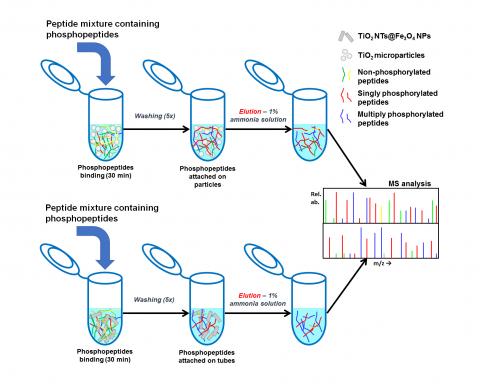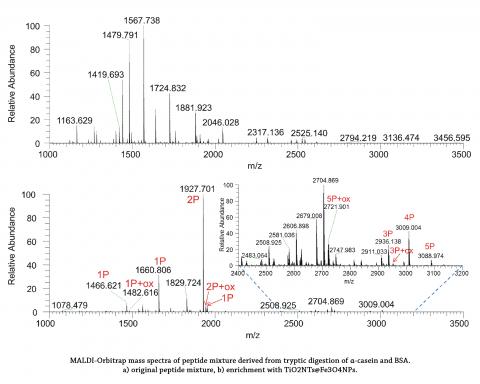New highly selective interface for phosphoproteome profiling
INTRODUCTION:
Phosphorylation is a reversible covalent modification of proteins/peptides which influences processes in cells, tissues or body. Studying these processes is important to identify and describe the relationship of the phosphorylation with the pathogenesis and development of serious diseases, for example Parkinson´s disease or Alzheimer´s disease.
TECHNOLOGY (INVENTION) DESCRIPTION:
The low abundance, low ionization efficiency, labile phosphate moiety and the interference of non-phosphorylated peptides strongly limit the characterisation of the processes. The specific phosphopeptides enrichment is critical for phosphoproteomic analysis. To address needs for phosphopeptides enrichment approach such as high selectivity and simplicity of operation, a high surface area interface, based on anodic one-dimensional (1D) TiO2 nanotubes homogeneously decorated by Fe3O4 nanoparticles (TiO2NTs@Fe3O4NPs) was introduced. The combination of TiO2NTs@Fe3O4NPs with tailored isolation protocol offers an enhanced separation specificity, enrichment ability and possibility to widen the range of identified peptides compared to the established TiO2 microspheres and IMAC-based protocols.
ADVANTAGES OVER EXISTING SOLUTIONS:
The material is nontoxic, robust, it can be easily separated from any solution due to its intrinsic magnetism, and being based on TiO2 it can be simply decontaminated by UV-light-induced photocatalytic treatment at low costs and reused again at the same quality. Our results have proved that the material (TiO2NTs@Fe3O4NPs) retains almost exclusively phosphopeptides and shows 50% better preferential affinity for double or triple phosphorylated peptides. Moreover it retains high number of unique phosphopeptides impossible to be isolated by other techniques. This attribute is fully exploitable mainly for analysis of hyperphosphorylated proteins associated with serious degenerative diseases.
DEVELOPMENT STATUS (STAGE):
Series of functional samples were prepared. Up-scale for preparative use possible.
PUBLICATIONS:
Paper recently subbmitted to Journal of Chromatography A (January 2018).
IP PROTECTION STATUS:
US application pending, priority 2014. CZ patent granted. New priority application in preparation, filing 1Q 2018.
TECHNOLOGY / IP OWNERS :
University of Pardubice


More information
More information is available upon signing a CDA / NDA (Confidential Disclosure Agreement / Non-Disclosure Agreement)